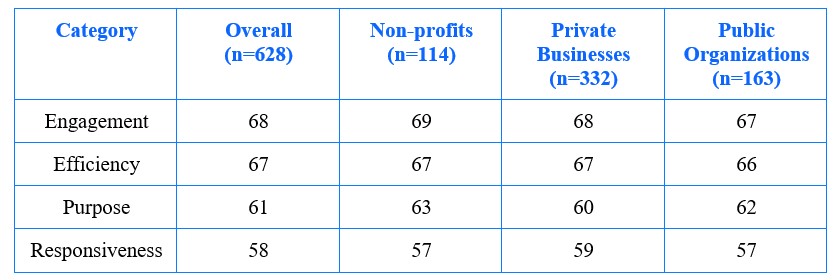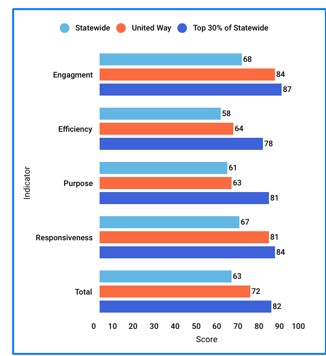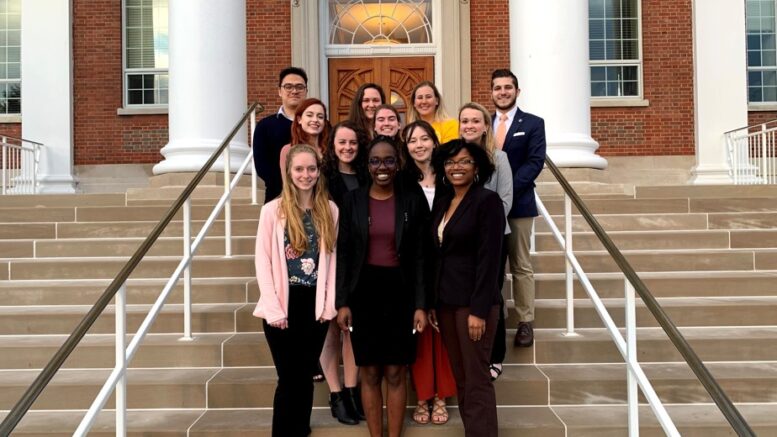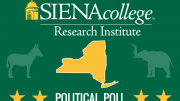Crosstabs Press Release Presentation
Introduction
As a part of a community-based research class at Siena College, we studied organizational culture. Organizational culture is the various values and beliefs that guide the behaviors that influence workplace environment specific to an organization. Each organization has a unique organizational culture that contributes to the functionality of the organization and the way employees behave within and outside of their organization.
Our community-based research class focused on understanding the organizational culture by partnering with three different organizations: The Boys and Girls Club, Unity House, and The United Way of the Greater Capital Region (UWGCR). Our group worked with the United Way of the Greater Capital Region and analyzed the specific organization within the organization. In order to effectively research organization culture, we paired with the Siena College Research Institute (SCRI). In conjunction with SCRI, we developed a statewide survey that reached a representative sample of New York State employees.
Through qualitative and quantitative research methods we were able to analyze the United Way of the Greater Capital Region’s organizational culture. We were also able to compare these results to non-profits, private business, and public organization in New York States. This process allowed us to analyze the strengths within the United Way of the Greater Capital Region and also identifies areas that could use work. Overall, we have completed a final product that provides a better understanding of the unique organization culture within the United Way of the Greater Capital Region.
Methodology
Although as a class we were focusing on analyzing organizational culture for non-profits as a group we focused on one specific non-profit organization. There were several steps that needed to be taken in order to successfully understand the organizational culture of United Way of the Greater Capital Region.
Over the course of the semester the United Way group extensively developed the methodology to effectively determine the culture at the organization. One of the first steps taken was the well-planned observations implemented by us. We were a group made of four female students working together to un-pack the culture of United Way. We conducted one observation each on various United Way meetings in differing locations, such as Boys and Girls Club of the Capital Area. All of our observations differed leading to more conclusive results. The observations typically ranged from 45 minute to hour long meetings where we focused on how the meetings were run and how the employees interacted with each other.
After the observations were finished we began to conduct interviews with United Way employees we each conducted two interviews. The purpose of the interviews were to better understand a non-profit’s employee daily work life. Our questions were based on discovering how satisfied they were with their workload. Or how they were adjusting to having new leadership within the organization. After completing our observations and interviews we resulted in having an overall total of four observations and eight interviews. With 75 percent of of the work completed we were able to move on to creating surveys.
Community Development 210 class collaborated with the Siena College Research Institute to create and develop surveys based on the organizational culture of the three non-profit organizations Boys and Girls Club, Unity House and United Way. Aside from the generic questions, we also included Organizational specific questions based on the data we collected from United Way. Through the use of the interviews and observations we were able to send out surveys based under the four quadrants. Engagement, Efficiency, Purpose and Responsiveness were the four quadrants used to analyze the culture of United Way. The surveys presented sufficient evidence on how the organization operated internally and externally.
The final stage was analyzing the data and presenting the conclusions to an employee of United Way. On Tuesday, April 23 the four of us stood in front of UWGCR’s Chief Executive Officer Peter Gannon to present the data gathered from our survey. Through the use of observations, interviews and surveys we were able to collect conducive evidence. We were able to conclude that although there are quadrants that United Way excels in there are still quadrants that they needed to improve on. Later on in this executive summary you will read on the specifics of the four quadrants and why they are important to the research.
In conclusion the methodology was an important and impactful part in discovering the organizational culture of United Way of the Greater Capital Region. Without the methodology we would not be able to understand the limitations presented when gathering the data for the research. Through creating an extensive methodology we were able to gather more accurate and effective conclusions.
What is Organizational Culture? How to Measure Organizational Culture.
The research the class conducted looked into and assessed the organizational culture of United Way of the Greater Capital Region. In order to measure organizational culture within UWGCR, the class broke the term into four quadrants. The quadrants include Engagement, Efficiency, Purpose and Responsiveness.
- Engagement determines how team oriented the organization is, and if they are truly a ‘we’.
- Efficiency measures how highly functioning the organization is, using effective processes balancing the quantity and quality of work.
- Purpose analyzes the direction of the organization, if the employees understand where the organization is going and if there is a clear plan outline how to get there.
- Lastly, Responsiveness measures how well the organization responds to its community, listening to the communities needs and making changes accordingly.
Findings
In a statewide sample of New York Businesses, nonprofits in general performed better than private businesses in engagement and purpose. They performed equally in responsiveness, and worse in efficiency. Statewide as a whole, businesses score best in engagement and responsiveness. They struggle the most in purpose and efficiency. In other words, businesses generally are good at engaging their employees, and listening to the needs of the clients. They are not so good at communicating their purpose to the community, and businesses struggle with doing things as efficiently as they could. The table below shows the overall findings from the statewide survey for overall, as well as a breakdown of nonprofits, private businesses, and public organizations.

The United Way of the Greater Capital Region itself has slightly different results. UWGCR performed strongest in engagement with a score of 84, second was responsiveness with a score of 81, next was efficiency with 64, and they performed weakest in purpose with a score of 63. UWGCR does well at keeping their employees motivated and engaged, and they are good at responding to the needs of their community, but they struggle with performing tasks in the most efficient way and they could improve upon how they project their purpose to the community.
These results are seen in the interviews we conducted prior to the survey being sent to employees. The high score in engagement is seen in a quote from an employee, “it is a family environment…our employer has the awareness that you are a person.” The employee says this when discussing the good work/life balance that the United Way encourages among their employees. Another employee also talked about the employee engagement committee that the UWGCR has and speaks to the legitimacy of it as a means of keeping employees in touch and happy. Additionally, employees talk about policies that make them feel welcome to speak up, “Peter has an open door, so I don’t think people feel like they can’t voice their opinion.”
When it comes to the lowest two categories of purpose and efficiency, employees have less to say. One employee sums up the dilemma that the United Way has with communicating their purpose, “I think a lot of times people aren’t exactly sure of what United Way does.”
At the United Way specifically, we found that the new change in leadership has had a positive impact on the organization. Employees were given the indicator “Now thinking specifically about your experience working at The UWGCR-The recent change in leadership has had a positive impact on employee morale” 94% of employees who participated agreed. Additionally, employees were given the indicator “UWGCR’s leadership promotes a positive, collaborative work environment” and 94% of participants also agreed with that. These two indicators show that the new leadership is having a positive impact on the organization. These statistics are backed up with quotes from our interviews. When asked about this change in leadership, one employee says, “ it is definitely
a lot more stable and a lot more clear vision on where we are and where we need to be and what’s expected.” Another employee says, “we got a CEO who is very different. The culture definitely changed for the better. There were some campaigns that struggled before and we’re definitely headed in the right direction now.”
Findings show that compared to the overall statewide results, the UWGCR performed better in all four quadrants. However, compared to only the top 10% of statewide businesses, the United Way has room for improvement. The graph below shows where the UWGCR falls in comparison to other respondents. As you can see, your organization is doing very well in comparison but to be in the top 10% there are improvements to be made especially in the efficiency and purpose quadrants. In engagement and responsiveness, your organization is only several points away from scoring what the top businesses in the state scored, this is something to be proud of and with a few improvements the United Way has a great chance.

| Recommendation 1: Analyze workload to staff ratio Recommendation 2: Clearly define The United Way of the Greater Capital Region’s mission so that it may be clearly communicated within the organization and to the community |
Conclusion
Overall, the United Way of the Greater Capital Region scored relatively high as an organization. Compared to the overall scores for the statewide analysis, UWGCR scored higher in three out of four quadrants: engagement, purpose, and responsiveness. However, when compared to other nonprofits statewide UWGCR only scored higher in two of the quadrants: engagement and responsiveness. Furthermore, when compared to the top 30 percent of overall organization surveyed in the statewide analysis WGCR was outscored in every quadrant. Thus, even though WGCR did receive relatively high score our data demonstrates there is still room for improvement.

The two highest scoring quadrants for the United Way of the Greater Capital Region were Engagement and Responsiveness. Our survey results demonstrated that employees enjoy coming to work every day and are passionate about the work that they are doing. In addition, employees believe that UWGCR leadership promotes a collaborative work environment that is upheld throughout the organization. These findings were initially identified through our interviews and observations and further supported by the data we received from the survey results.
Another high scoring quadrant for UWGCR was responsiveness. This quadrant focused on how well an organization responds to the community and adjusts accordingly. Through our qualitative research, specifically speaking with staff, we found that the UWGCR made an effort to focus on the community’s needs and adjust when necessary. This was especially important to staff when developing new programs. For example, a staff member explained that“we’re actually calling 2019 the year of trying something new … we want to see what the community is interested in”. These findings were evident throughout survey responses as well. The United Way’s commitment to the community’s needs was a pertinent factor in the organization high score. While the organization had exceptionally high scores in engagement and responsiveness, progress can be made within efficiency and purpose.
Efficiency was the second lowest scoring quadrant. Throughout our interviews and observations we dedicated that while the staff was passionate about the work they were doing, they often felt overwhelmed with the workload. The survey results pointed to similar problems with intense workloads and staff holding too many responsibilities. This quadrant was one that the United Way of the Greater Capital region has an opportunity to work on in order to improve their organizational culture.
The lowest scoring quadrant was purpose. This quadrant focused on whether or not the organization has a vision and direction that is openly and clearly communicated. They are positive findings within the quadrant were that employees felt that the organization was innovative and set a realistic goal for the future. However, the survey revealed that few employees understand the vision of the organization. Also, as one staff member put it “people aren’t exactly sure of what United Way does”. Thus, in order to improve the score of the quadrant, the United Way should focus on clearly identifying what their mission is. Then, effectively communicating that mission to the staff so that they can clearly communicate is to the community.





